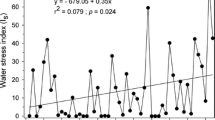Abstract
Radial growth responses to drought were examined in the tree-ring records of six species growing within two locations of differing land-use history and soil moisture characteristics, and in overstory and understory canopy positions in northern Virginia. Tree species experienced differential ring-width reductions during or immediately following four severe drought periods occurring from 1930 to 1965 and were influenced by climatic variables including annual and summer temperatures, annual precipitation, and annual Palmer Drought Severity Index. Relative growth comparisons averaged across species before and after drought years indicated that understory trees on dry-mesic sites grew 11% faster after drought compared to pre-drought rates while mesic site trees in both canopy positions grew approximately 4% slower. Superposed epoch analysis indicated that Liriodendron tulipifera growing on mesic sites experienced greater ring-width reductions associated with drought than co-occurring, more drought-tolerant Quercus alba and Q. velutina. On dry-mesic sites, L. tulipifera also experienced greatly reduced growth as a result of drought but exhibited significant growth increases following individual drought events. Quercus alba was the only species that exhibited a consistent, significant ring-width decrease associated with all droughts on dry-mesic sites. In contrast, Pinus virginiana was least impacted by drought on dry-mesic sites but was much more impacted by drought on mesic sites, indicating a drought×site interaction for this species. Overstory Carya glabra and Q. alba experienced larger growth decreases during drought on dry-mesic versus mesic sites. Understory tree growth reductions did not differ between site types but were often significantly larger than overstory responses of the same species on mesic sites. Following drought, most trees exhibited growth reductions lasting 2–3 years, although several species experienced reductions lasting up to 6 years. The results of this study suggest that tree rings represent an important long-term proxy for leaf-level ecophysiological measurements of growth responses to drought periods.
Similar content being viewed by others
Author information
Authors and Affiliations
Additional information
Received: 31 July 1996 / Accepted: 16 April 1997
Rights and permissions
About this article
Cite this article
Orwig, D., Abrams, M. Variation in radial growth responses to drought among species, site, and canopy strata. Trees 11, 474–484 (1997). https://doi.org/10.1007/s004680050110
Issue Date:
DOI: https://doi.org/10.1007/s004680050110




